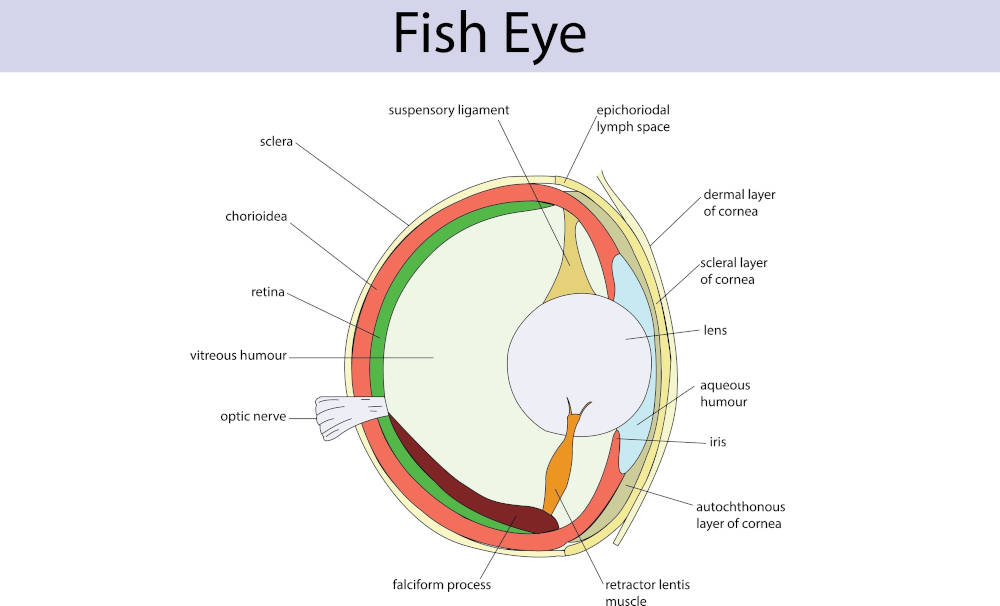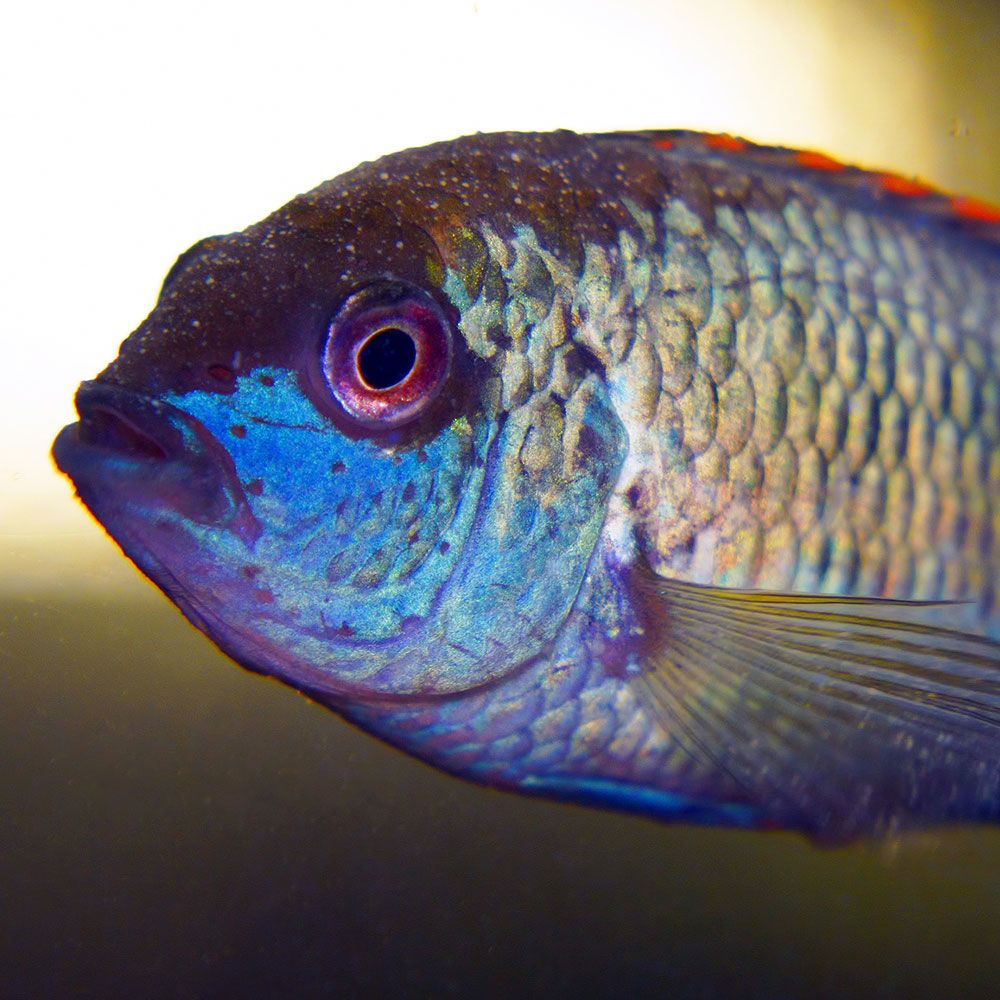Most fish don’t have eyelids as they don’t need them underwater to moisten their eyes or protect them from dirt and dust. But some fish, like sharks, have eyelids. Other fish have thick and transparent special eyelids, which help them see clearly.
Eyelids are one of the most essential body parts for a human being. They protect our eyes from dust and keep them moist.
In fact, on average, we blink about 15-20 times a minute to keep our eyes clean. On the other hand, most fish live without it for their entire life.
This often makes aquarists curious about a ton of things – like whether their fin buddies stay eternally awake or how they protect their eyes when in danger.
To know it all, let’s first read about their eyes.
What are Fish Eyes?
Fish eyes are unique and built for underwater life. Before you get into the details, let’s dive into a little backstory here.
What is the background of a fish eye?
Let’s understand the evolutionary history of the vertebrate eye— a structure shared by both fish and humans.
Originating in the ancestors of fish, the vertebrate eye evolved to suit an aquatic environment. In this, the eye’s surface remains consistently moist.
The eye is not suited for air exposure, as there’s a risk of drying out.
What is the Anatomy of a Fish eye?

This sensory organ of fish consists of various essential components. Each of these together helps them navigate their everyday life. So, let’s know about each part here.
1. Cornea
The cornea is the outer protective layer in fish eyes. Thicker than those in land animals, fish corneas provide resistance to underwater pressure and protect sensitive eye tissues. Their round shape allows the fish to get almost a full hemisphere or 360-degree view.
Furthermore, the cornea’s density matches that of water. This nullifies water’s image-bending effect and ensures accurate transmission of images.
2. Lenses and Retina
Fish eyeballs are composed of lenses, retinas, and other essential components.
Fish eye lenses are larger, thicker, and more spherical compared to those of land animals and facilitate improved vision underwater.
The flexibility of these lenses allows fish to adjust their shapes and focus on different distances. They refract a significant amount of light.
The retina, a critical component for processing visual information, contains rod and cone cells responsible for light and color detection. While their vision spans almost 360 degrees, clarity is highest in the middle.
3. Iris Structure
Unlike land animals, fish don’t have an adjustable iris, except for a few shark species. Instead, they control light levels by moving their irises up and down. It’s a slower process and takes 15-20 minutes to adapt to changing light.
4. Bioluminescent Flashlight Fish
Some deep-sea fish, like bioluminescent flashlight fishes, have specialized light-producing organs beneath their eyes. These enhance their vision in low-light conditions, aiding in prey location and capture.
Do fish have eyelids for eye protection?
Most fishes do not have traditional eyelids. Some shark species have an eyelid-like transparent membrane that closes during attacks. Others rely on various defenses for eye protection.
Additional adaptations, such as tubular eyes and a thin mucus layer known as the conjunctiva, are present in different fish.
Alternative strategies include certain bonefish using a fatty layer as a makeshift eyelid and some fish having light-activated pigments that darken for protection against bright lights.
Some also have specialized movements and secretions to keep their eyes safe.
Unlike land animals that blink to keep their eyes moist, fish without eyelids rely on their watery surroundings for moisture. So they don’t need traditional blinking mechanisms.
What are Adipose eyelids?
Some fish have a protective membrane or a fatty adipose eyelid covering some or all of their eyes. These specialized eyelids are like glasses or lenses. They enhance underwater vision and help in navigating obstacles and moving swiftly.
Composition
The main components of adipose eyelids are epithelial and connective tissue formed from collagen fibers. Some fish have connective tissue in the middle layer, binding the others.
Thickness varies, being thinnest over the eyeballs and thick towards the cheek and face.
Filtering Specifics
Adipose eyelids filter light below 305 nanometers, with varying concentrations of epithelial tissue. They can reflect light based on polarization and angle of exposure.
What are the functions of Adipose eyelids?
Adipose eyelids have several important functions like the following:
- They improve vision in dark sea areas.
- They act as shields to prevent harmful debris in the water from harming fish eyes.
- They might protect fish eyes from damage caused by bright light, like sunglasses.
- They act as an extra lens for focusing, a polarizing filter, and a UV filter, and they even contribute to a ‘streamlining’ structure.
Do Sharks have Eyelids?

Sharks have protective eyelids with two main structures.
Some have upper and lower eyelids that close during feeding. They don’t close all the way. Some examples are great whites, threshers, sand tigers, dogfish, shortfin makos, and basking sharks. They roll their eyes backward during hunting.
Others have a clear third eyelid known as a nictitating membrane, which slides down over the eyeball for protection during hunting. Most sharks, including tiger and hammerhead species, use this membrane.
Which are the fish with eyelids?
Some rare fish that have eyelids are:
- Sharks
- Rays
- Salmon
- Trout
- Milkfish
- Jacks
- Mullets
- Mackerel
- Isospondyls (like herring)
Can Fish Blink without Eyelids?
Fish, without eyelids, can’t blink. Like humans, they don’t face the risk of corneal exposure, but they need protection. So, they have evolved fast protective reflexes as survival instincts, such as mimicking eyes (eyespots) to confuse predators.
On the other hand, some sharks may have lateral-moving eyelids for blinking.
Mudskippers are unique for their blinking motion when exposed to air. They pull their eyes into the socket, covered by a stretchy dermal cup. This keeps their eyes moist while out of water.
How do fish sleep?
There’s a myth that fish never sleep because their eyes are always open. But they don’t have to close their eyelids while resting.
Fish exhibit unique sleep patterns despite lacking eyelids. Some lie motionless, often at the bottom or near the water’s surface, and their gill movements slow down.
Some fish also nestle in sand, while others hide in coral or caves. Parrot fish secrete mucus for added protection during sleep.
How do fish sleep in schools?
Fish in large schools adopt a collaborative approach to sleep. While some stand guard, others rest and keep altering roles. This teamwork ensures collective safety during vulnerable moments.
What are the Signs of a Sleeping Fish?
If you’re curious whether your aquarium fish is sleeping or not, look for these signs.
- Stillness for a few minutes
- Floating still
- Delayed responses
- Consistent rest times every day
- Drifting in the water
Difference between fish estivation and sleep?
Certain fish practice estivation – a sleep-like state similar to hibernation for months or years. It happens only during dry climates when there’s food or water deprivation.
A word from FishInAquarium
Most fish – worldwide and in your aquarium – lack eyelids. With their smart strategies, they adapt to this perfectly! Of course, some have adipose eyelids – but they’re definitely not the common ones for aquariums.
With that said, remember to treat your aquarium fish eyes delicately. While setting up aquariums, be extra alert about sharp objects.
Did you find this info helpful? Share it with fellow fish enthusiasts. For questions or assistance, drop us an email. Happy fishkeeping!


